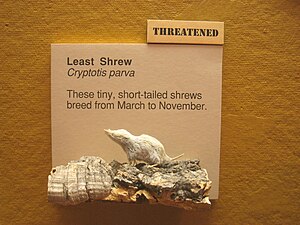Small ear shrews
| Small ear shrews | ||||||||||||
|---|---|---|---|---|---|---|---|---|---|---|---|---|

Cryptotis parva |
||||||||||||
| Systematics | ||||||||||||
|
||||||||||||
| Scientific name | ||||||||||||
| Cryptotis | ||||||||||||
| Pomel , 1848 |
The small ear shrews ( Cryptotis ) are a species of shrew that is widespread in America .
features
Small ear shrews are comparatively small shrews, they reach head body lengths of 5 to 10 centimeters, including a 1 to 4 centimeter long tail, and a weight of 4 to 7 grams. The fur is brown or black on the upper side, the underside often only a little lighter. The name-giving feature are the small ears that barely protrude from the fur, and the eyes are also small.
distribution and habitat
The distribution area of the small ear shrews extends from southeast Canada and the eastern USA via Central America to northern South America ( Colombia , Ecuador , northern Peru and Venezuela ). This makes them the only genus of shrews, in fact the only genus of insectivores that lives south of Guatemala and is also found in South America. Its main distribution is in Central America, in Canada and the USA only one species lives with Cryptotis parva .
Their preferred habitat are forests, but some species (such as C. parva ) are also found in grasslands.
Way of life
Small ear shrews are both diurnal and nocturnal and are primarily characterized by the fact that, in contrast to the other - mostly solitary - shrews they live in groups and lead a more social way of life. At least Cryptotis parva , the best-researched species, is known to build nests that are shared by several animals. These nests can be in earthworks that you have dug yourself or taken over by other animals, under tree trunks or in crevices. They are approximately round and consist of dry grass and leaves.
Their diet consists of insects and other invertebrates, small vertebrates such as lizards and frogs, and carrion.
Reproduction has only been researched for Cryptotis parva . In this species, the female gives birth to around 5 young after a gestation period of 21 to 22 days. These are suckled for around 20 days and are sexually mature at 30 to 36 days.
Danger
The IUCN lists 8 small ear shrews in the categories endangered, critically endangered and critically endangered. 7 other species are classified in the insufficient data category. Several of these endangered or little-known species have very small ranges and are threatened by habitat loss. Nelson's small ear shrew only occurs in the area of a single volcano in southern Mexico and was not seen between 1894 and 2004.
Systematics
The exact number of species of small ear shrews has not yet been clarified. Older works assumed there were 12 to 18 species, but more recent classifications differentiate between up to 33 species. The following types are currently known:
literature
- Ronald M. Nowak: Walker's Mammals of the World. 2 volumes. 6th edition. Johns Hopkins University Press, Baltimore MD et al. 1999, ISBN 0-8018-5789-9 .
- Don E. Wilson , DeeAnn M. Reeder (Eds.): Mammal Species of the World. A taxonomic and geographic Reference. 2 volumes. 3. Edition. Johns Hopkins University Press, Baltimore MD 2005, ISBN 0-8018-8221-4 .
Web links
- Endangerment level of the individual species in the IUCN Red List of Threatened Species .